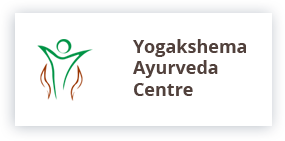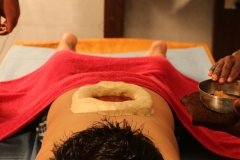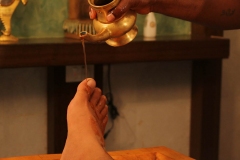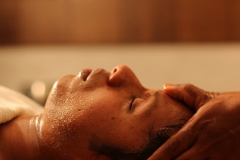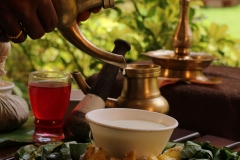Pancha Karma
The Ultimate Mind and Body Rejuvenation
Panchakarma is the ultimate mind-body healing experience for detoxifying the body, strengthening the immune system, and restoring balance and wellbeing. Developed thousands of years ago in India, Panchakarma is the cornerstone of ayurvedic practice.
According to Ayurveda, good health depends upon our capability to fully metabolize all aspects of life, assimilating the vitals that nourish the body and eliminating the rest. When we can’t completely digest our food, experiences, and emotions, toxins accumulate in our bodily tissues, creating imbalance and – ultimately – disease. Panchakarma is a cleansing process that releases stored toxins and restores the body’s innate healing ability.
When toxins accumulate in the body, they block the flow of energy and nourishment throughout the system. Ayurveda considers this buildup of toxins the underlying cause of all disease. It is important to remember that your mind and heart are continually digesting energy and information as well. Panchakarma is a time-proven natural therapy that detoxifies and restores the body’s inner balance and vitality.
The Panchakarma Process
In Sanskrit, Panchakarma means “the five actions”, referring to the five different cleansing and rejuvenating procedures described in classic Ayurvedic textbooks.
As Panchakarma has been practiced over thousands of years, the therapies have evolved according to the times. The procedures also vary according to an individual’s mind-body type (dosha) and health concerns. However, the principles of purifying and replenishing remain the same.
Panchakarma follows these steps:
Purvakarma
Panchakarma begins with oleation – applying and ingesting pure essential oils in order to loosen and mobilize accumulated toxins. This step includes supplementation with organic seeds, as well as deep, soothing daily Ayurvedic massage treatments using herbalized oils.
A vital aspect of this step is swedana where specific steam and warm oil therapies are used to heat the body. This process helps open the body’s circulation channels and allows toxins to flow more easily from the tissues to the gastrointestinal tract for elimination. Swedana also relaxes the body, releasing tension and allowing impurities to be eliminated through the sweat glands.
Pradhanakarma
Once the body’s toxins have been mobilized, gentle therapies are used to release them from the body. The treatment includes a sequence of daily bastis – a therapeutic process in which medicated oils and herbal preparations are used to flush toxins from the intestinal tract. Bastis are often referred to as enemas, but actually offer many more healing benefits than a simple colon cleanse. During a basti, the herbalized oils enter the deeper tissues and eliminate fat-soluble toxins that can’t be dislodged with standard enemas.
Vamana
Inducing vomiting specially for kapha related respiratory tract illnesses, arthritis, like asthma, psoriasis, acne, arthritis, and diabetes.
Virechana
Induced purgation specially for elimination of Pita related toxins from the body.
Nasya
Nasal cleansing by the application of medical oils or powders. This is helpful in conditions like allergic sinusitis, migraines and epilepsy.
Vasti
Medicated enema is particularly good for alleviating excess Vata. Vasti’s effects are directly felt in the colon, the prime abode of the Vata. Vasti is good for spleen disorders, colic, calculus, kidney stones and many other diseases due to a Vata disorder.
Nirooha Vasti
Enema using a special combination of herbal decoctions, paste, powders and oils. It has an effect on the nervous system to help eliminate the imbalances in Vata.
Rakhtamoskhana
To remove impurities from the blood.
Paschatkarma
Once the toxins have been released, this is a critical time to begin replenishing the body with natural foods and herbs, revitalizing massage treatments and healing practices such as meditation and yoga.
Ayurvedic physicians recommend getting regular panchakarma treatments to detoxify and nourish your entire mind-body system. In just a few days, you will feel renewed as you release whatever is no longer serving you and open yourself to vibrant health.
Chikitsa (Ayurvedic Treatments)
Ayurvedic treatment does not mean suppressing the main symptoms and creating some new ones as side effects of the main treatment. It is to remove the root cause and give permanent relief.
There are four main classifications of management of disease in Ayurveda: Shodan (cleansing) Shaman (palliation) Rasayana (rejuvenation) and Satvajaya (mental hygiene).
The following conditions are treated by Ayurvedic treatments:
Abdominal Infections | Abdominal Distension | Indigestion | Acne | Allergic Rhinitis | Anxiety | Asthma | Bloating Sensation | BPH (Benign Prostatic Enlargement) | Chronic Fatigue Syndrome | Chronic Constipation | Cervical Spondylosis/ Spondylitis | Depression | Diabetes (Prameha) | Dry Eye Syndrome | Dysentery | Dyslipidemia | Eye strain | Frozen shoulder | Gallstones | Gastritis | Glaucoma | Gout | Gynecological Conditions | Hair Loss | Raynaud’s Syndrome | Sinusitis | SLE- Systemic Lupus Erythematosus | Tennis Elbow | Thyroid Dysfunction | Heart Burn | Hepatosplenic Dysfunctions /Diseases | Hypertension | Irritable Bowel Syndrome | Insomnia | Lower Back Ache | Low Blood Pressure | Lumbar Spondylosis | Meniere’s Disease | Menopausal Syndrome | Mental Stress | Memory Loss | Migraine | Multiple Sclerosis | Neuralgic Complaints | Neuralgic Headache-Tension Headaches | Osteoarthritis – Multi-Joint | Obsessive Compulsive Disorder | Skin Diseases like Eczema, Dermatitis | Obesity | Piles /Hemorrhoids | Post Chemotherapy/ Post Radiotherapy | Psoriasis | Rheumatoid Arthritis | Rheumatism Tinnitus | Ulcerative Colitis | Underweight | Urinary Infections | Vitiligo/Leukoderma | Varicose veins
